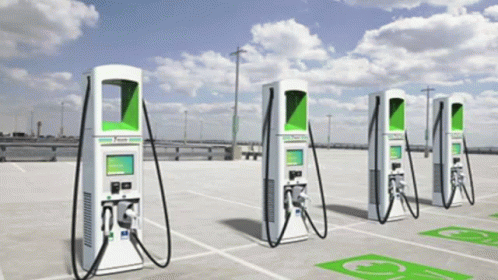In a global climate increasingly punctuated by urgent dialogues around sustainability and the existential threat of climate change, the emergence of electric vehicles can be likened to a veritable beacon of environmental stewardship. This isn’t just a technological advancement; it’s a potent symbol of a societal shift towards greater eco-consciousness. Nowhere is this paradigmatic change more salient than in India, a country that combines a bustling population with burgeoning economic promise. As a microcosm of broader global challenges, India is particularly well-suited to reap the benefits of this automotive transformation, and its government has been nothing short of audacious in setting its sights on this new frontier.
What makes this ambition so daring yet so timely is the interlocking nature of India’s transportation needs and its climate imperatives. India isn’t just embracing electric mobility as a means to reduce traffic congestion or lower fuel import bills, although those are certainly appealing incentives. Rather, it has positioned the transition to EVs within the broader framework of its commitments to reduce carbon emissions and contribute to global efforts aimed at climate mitigation. It’s a monumental task that requires a recalibration of infrastructure, policy, and public perception.

This aspiration to switch to 100% electric mobility by 2030 is part of a larger Indian vision that marries technological progress with sustainability, a vision that aligns remarkably well with global climate objectives. Indeed, the initiative echoes international accords like the Paris Agreement, contributing to collective endeavours to curtail greenhouse gas emissions. Moreover, it represents an essential facet of India’s broader sustainable development goals, encompassing not only environmental but also social and economic dimensions.
The boldness of this objective cannot be understated. It embodies a potent blend of foresight, aspiration, and responsibility—a complex balancing act that aims to propel the nation into a new age of mobility while remaining acutely cognisant of its environmental repercussions. In so doing, the Indian government isn’t merely capitalising on a technological trend; it is seizing an invaluable opportunity to reorient both national and public interests towards a future that is as sustainable as it is innovative.
Thus, India’s commitment to transitioning to 100% electric mobility by 2030 serves as a beacon to the rest of the world. It demonstrates a comprehensive understanding of the multifaceted crises we face today—social, economic, and above all, environmental—and serves as an emblem of proactive and responsible governance.
Electric vehicles stand as a seminal breakthrough, far transcending mere vehicular technology to represent an epochal shift in the socio-economic and environmental landscape. The importance of this shift can scarcely be overstated. It is not just about replacing combustion engines with electric motors; it’s about altering the very ethos that underpins consumer behaviour, public policy, and corporate strategy, driving them towards an enhanced focus on sustainability and climate action.
In India, a nation with rapidly escalating urbanisation and an increasing environmental footprint, the recognition of this transformative power of electric mobility has been both swift and decisive. The government, in collaboration with the private sector, is not merely adopting electric vehicles as a convenient solution to contemporary challenges such as air pollution or energy security. Instead, it’s integrating EV technology into a broader canvas of sustainable development, one that aligns closely with the nation’s commitments to global climate initiatives.
The private sector, for its part, has picked up the gauntlet with vigour. Indian corporations are investing in research and development, not just in EV technology, but also in associated ecosystem elements like charging infrastructure, energy storage solutions, and even renewable energy sourcing. This underscores a holistic approach to sustainability, providing multiple touchpoints for environmental benefits.
What makes this convergence between government ambition and private sector innovation particularly potent is its timing. The threat of climate change is no longer a distant spectre but an immediate reality, compelling nations to reorient their developmental agendas towards more sustainable paths. In this context, India’s enthusiastic endorsement of electric mobility isn’t just a national strategy; it’s a global imperative, serving as a microcosm of the larger transformation that is both necessary and inevitable in the face of our current climate crisis.
Government Initiatives
FAME Scheme
The Indian Government, recognising the intertwined futures of climate action and transportation, has unveiled several potent initiatives. Chief among them is the Faster Adoption and Manufacturing of Hybrid and Electric Vehicles (FAME) scheme. Now in its sophomore phase, FAME extends both demand and supply-side incentives, a holistic approach that stimulates consumer interest while spurring automakers to invest in more sustainable vehicle technologies.
Investment in Charging Infrastructure

In the global narrative surrounding the adoption of electric vehicles, one phrase often rears its head: ‘range anxiety.’ This term encapsulates the concerns and hesitations that prospective EV owners have concerning the vehicle’s operational radius on a single battery charge. Range anxiety is considered one of the most significant psychological barriers inhibiting the widespread adoption of electric vehicles. A car, after all, is not just a means of transport but a symbol of freedom, the ability to traverse vast distances without impediment. Any limitation on this freedom, especially one tied to the vehicle’s core functionality, tends to invite scrutiny.
In a laudable attempt to address this very apprehension, the Indian government is embarking on a concerted effort to bolster the country’s charging infrastructure. Plans are well underway to establish charging stations at 25 km intervals along highways and expressways. The strategy, at its core, is a dual-pronged one. Firstly, it aims to alleviate the aforementioned range anxiety by offering frequent charging options. Secondly, and perhaps more crucially, it reflects an ambitious commitment to significantly lower carbon emissions by making electric vehicles a viable option for longer journeys, thereby reducing reliance on fossil fuel-powered transportation.
The Charging Infrastructure as a Sustainability Initiative
While it’s tempting to view this solely as a transport policy, it has deeper implications for sustainability and climate change mitigation. A robust charging infrastructure will directly contribute to reducing greenhouse gas emissions by encouraging EV adoption, which in turn will align with international climate objectives such as those stipulated in the Paris Agreement. India, being a signatory, has committed to reducing its carbon footprint, and strengthening the EV charging infrastructure emerges as a cardinal component in this context.
Intersecting Economic and Environmental Goals
The government’s initiative is not merely an environmental endeavor; it also holds substantial economic implications. It is an investment into future-proofing the Indian transport sector. As the world moves closer to a tipping point regarding climate change, future economic policies will inevitably intertwine more closely with sustainable practices. By laying the foundation for an EV-friendly nation now, India is positioning itself as a leader in the renewable energy transition, attracting both domestic and foreign investments in green technologies and sustainable transport solutions.
Public-Private Partnerships: A Synergy for Progress
The ambitious objective of establishing a charging station every 25 km necessitates significant financial resources and technical expertise. This is where collaborations between the public and private sectors can become particularly fruitful. Public-Private Partnerships can offer a win-win: the government provides policy support and perhaps even land allocations for charging stations, while private companies bring in capital and technical expertise.
Beyond Range: The Ripple Effect on Other Sectors
A widespread and efficient charging infrastructure has a ripple effect on several other sectors, notably the power and renewable energy sectors. As the demand for electricity increases with more EVs on the road, there’s an implicit incentive for investments in cleaner, renewable sources of energy. It becomes a virtuous circle: the more the country invests in renewable energy, the greener the electric vehicles become, thereby further reducing the carbon footprint per kilometre driven. Read more here
The Social Dimension: Educating the Public
It’s crucial not to overlook the importance of educating the public on the benefits of this initiative. Addressing range anxiety is not just about building physical infrastructure; it’s equally about building intellectual and emotional comfort around the adoption of EVs. Public awareness campaigns can significantly complement the hardware investments being made, thereby fostering a more rapid and widespread adoption of electric vehicles. Read more here
The Global Context: India as a Model
The ambitious charging infrastructure could make India a template for other developing countries grappling with similar challenges of balancing economic growth and environmental sustainability. It offers a case study in how a nation can leapfrog older technologies to adopt cleaner, more efficient systems, without necessarily going through the linear path of development that many Western countries have followed.
Balancing Act: Challenges and Future Outlook
The journey is not without its challenges. Land acquisition, power supply stability, and the actual implementation on such a massive scale are hurdles to be crossed. Furthermore, the 25 km interval strategy must be reviewed and iterated based on actual usage patterns, technological advancements in battery ranges, and the evolving landscape of India’s road networks. Nonetheless, none of these challenges are insurmountable, especially when the alternative is increased environmental degradation and missed economic opportunities.
The Indian government’s investment in establishing a comprehensive EV charging infrastructure represents a multifaceted strategy with profound implications for the country’s future. It aims to address the practical concern of range anxiety, thereby removing a key barrier to the adoption of electric vehicles. Simultaneously, it manifests a far-sighted commitment to sustainable development and climate change mitigation. By weaving together elements of transport policy, environmental responsibility, and economic foresight, India is not only setting a precedent for itself but also potentially laying down a roadmap for the world to follow in the challenging yet imperative transition to a more sustainable future.
Industry Response
Investment by Indian Companies in EV Development
Major Indian automobile conglomerates, including Tata Motors and Mahindra & Mahindra, are not merely aligning with governmental objectives but are making sustainability the linchpin of their corporate strategy. The commitment to R&D in electric vehicles is expansive, encompassing the spectrum of EV components, software solutions, and even charging stations—each of which has its own set of environmental merits.
Benefits of EVs
Reduced Air Pollution
One cannot discuss the benefits of electric vehicles without acknowledging their potential to mitigate one of India’s most pressing environmental crises—air pollution. As cities like Delhi, Mumbai, and Bangalore choke under the weight of their own pollution, the introduction of zero-emission electric vehicles could usher in a new dawn of cleaner, healthier urban living.
Lower Operating Costs and Climate Benefits
Electric vehicles also bring an economic rationality to the sustainability conversation. While the upfront costs may be somewhat prohibitive, they are offset by substantial long-term savings. Electric power is generally cheaper than fossil fuels, and the low-maintenance nature of EVs appeals to the consumer’s pocket. Moreover, the shift from fossil fuels to electric power could substantially reduce greenhouse gas emissions, aligning economic incentives with crucial climate goals.
Challenges and Potential Solutions
High Upfront Cost of EVs
Financial constraints remain a genuine concern, even in the face of FAME and other subsidies. To resolve this, innovative solutions such as additional tax incentives, palatable finance options, and bulk procurement for public transport could be examined. Such financial instruments not only make electric vehicles accessible but also encourage a society-wide shift towards sustainable transportation. Read more here
Limited Charging Infrastructure and Renewable Integration
The evolving but still inadequate charging network continues to be a stumbling block. Public-private partnerships can be particularly constructive in this domain. Strategic collaboration can lead to a swifter rollout of robust charging infrastructure. Moreover, ensuring that these charging stations are powered by renewable energy sources would solidify their status as a truly sustainable solution.
The Intersection of EVs, Sustainability, and Climate Change
As climate change looms large on the global conscience, the transition to electric vehicles takes on an urgency that transcends national boundaries. The proliferation of EVs is not merely a technological trend but an imperative for sustainable development. By adopting electric mobility, India is not just modernising its automotive industry; it is making a palpable contribution to the global fight against climate change.
Future Outlook for EVs in India
With robust support from the government, impressive capital allocation from domestic corporations, and an increasingly climate-conscious public, the trajectory for EVs in India seems not just promising but inevitable. Challenges are inherent, yet none appear intractable. India’s audacious yet thoroughly attainable vision of 100% electric mobility by 2030 serves as a sterling example for emerging economies and, indeed, for the world at large, particularly in our shared quest to combat climate change.
As a key player in the transport sector, Rally OurBus views the Indian government’s commitment to expanding electric vehicle infrastructure as an exciting and crucial opportunity for catalytic change. We recognise the symbiotic relationship between sustainable public transport and EV adoption, and we are keenly interested in aligning our strategies with this transformative shift towards environmental responsibility. Rally OurBus is a pioneering force in the transportation sector, ingeniously leveraging technology and market networks to revolutionise mass mobility. With its asset-less Virtual Bus Company model, We offer customised intercity travel by aggregating fleets from multiple bus operators. Additionally, the company’s On-Demand Middle Mile solutions adeptly manage surge demands through pop-up mass transit networks. Powered by an AI-driven Bus Platform, Rally OurBus automates industry operations and integrates first and last-mile connections. As a digital-first global brand, it not only owns critical industry intelligence but also deploys it through an expansive market network, making it a holistic mass-mobility ecosystem.
Our commitment doesn’t stop at mere adoption; we are looking into strategic partnerships with renewable energy providers to ensure that the electricity fuelling our vehicles comes from sustainable sources. By doing so, Rally OurBus not only aims to mitigate range anxiety but also seeks to contribute meaningfully to reducing the carbon footprint of public transportation in India. We believe that by acting as a forerunner in this greener, more sustainable model of transport, we can inspire both the industry and the public to accelerate the pace of change towards a more eco-friendly future.
